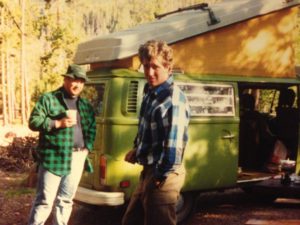Okay, so…it took a few days
It took me a few years to get to Puerto Escondido. It took a few days longer to get into the surf at Playa Zicatela, aka: the Mexican Pipeline.
I spent the first few days after my arrival surfing the waves at La Punta, a point break at the south end of Playa Zicatela. The irony was thick: instead of a hollow beach break right, I was surfing a mushy point break left. On top of that, the break was packed with people.
Like all point breaks, there are only one or two takeoff spots, and those spots were dominated by the locals. Curious sidenote: at La Punta, those aggressive locals were a pack of kids, maybe teenagers, and a lot of them girls; seeing such a lineup was a first for me. And since I’m way past being overly aggressive when it comes to battling for waves (and I also didn’t want to be yet another aggressive visiting American surfer), there was a lot of sitting around and only sporadic wave riding. Oh well. The waves I had were fun and each day was an enjoyable outing. Having pelicans divebombing fish just a couple of feet away from you is surprising at first, but the birds do it so much that it becomes barely noticeable. But it’s still really cool and made me smile every time. As the birds would surface beside me I’d ask them if they’d been successful. Most just gave me the stinkeye, as if I were going to steal their lunch, before swimming away.
But the goal was to get out at Zicatela and with the swell dropping over the week, I made it. I’ve spent the past few days surfing Zicatela. There are still plenty of sets — groups of waves quite a bit larger than the average waves — and I’ve taken a couple on the head and survived, which was reassuring — but paddling out and staying out of trouble has been doable, letting me concentrate on surfing.
Though I’m not sure I’d call what I’ve been doing “surfing.” Mostly, I’ve been struggling with my wave selection and my takeoffs. I’ve been staying away from the well-overhead set waves (and some that were double overhead-plus) but I still wind up paddling into waves that do nothing more than close out (for nonsurfers: a close out is a wave that breaks all at once, leaving you no face to ride). And on plenty of waves, closeout or not, the steep drops have led to a lot of face plants and free falls. I have not been carving a graceful figure in the water.
The fact is: I don’t have a lot of experience on steep, hollow waves. Even in California, the waves don’t stand up like they do at Zicatela. It’s REALLY cool to be in the water and see waves break the way you’ve seen them in the magazines for decades, the way you drew them on your notebooks in school. But it’s another thing to successfully ride them. At least it is for me.
The difference between this type of wave and what I’ve been surfing on both coasts of the U.S. is night and day. I’ve often said that, as with many of my pursuits, I’m not a very good surfer but I am an avid one. My experience at the Mexican Pipeline has, thus far, been very humbling. I don’t know how far I’ll get in the few days I have remaining — a lot of that will depend on the swell — but I will keep trying. And when I get home, I’m going to be a lot more aggressive about taking off on seemingly unmakeable waves. That way, the next time I come to Puerto Escondido — and I will be back — I’ll be better prepared for the Mexican Pipeline.



